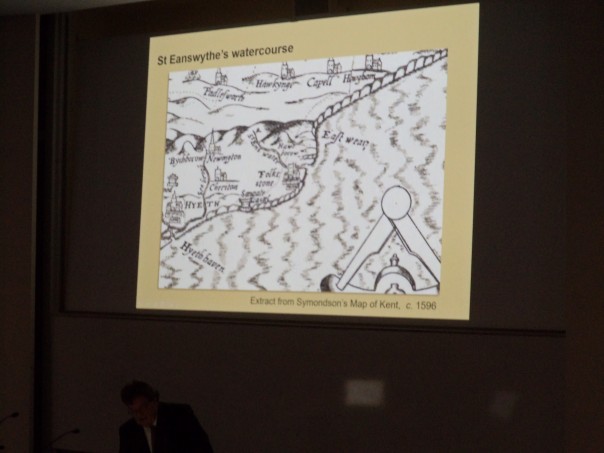I thought I would begin where in a sense I left off, and now that the programme for Women’s International Day and Women’s History Month is now up on the CCCU website, I thought I would give you the link: https://www.canterbury.ac.uk/equality-and-diversity/edi-events/international-womens-day-and-womens-history-month.aspx so please feel free to check out what will be going on next month, including the two events involving the Centre.
Also, on Saturday 2 March Dr Diane Heath and I will have a stall at the Faversham and Swale Heritage Fair (organised by the Faversham Society) in the Alexander Centre, Faversham, and we are both giving short talks there too. At 11.30 I’ll be discussing ‘Faversham: one of Archbishop Cranmer’s ‘troublesome’ towns in 1542’ and then at midday Diane will speak on ‘Investigating Faversham’s Fourteenth-century Book of The Dead’. Please do come and see us at our stall and all the others if you are in the area.
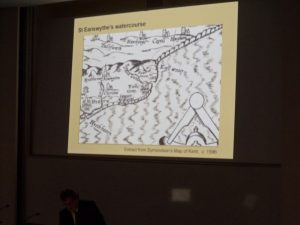
Paul Bennett discusses the St Eanswythe watercourse
Then for those on Kent’s south coast there is the ‘Finding Eanswythe: the Life and Afterlife of an Anglo-Saxon Saint’ exhibition. This is now open at the Sassoon Gallery until 17 March and there are several free events going on as well. You can receive details by emailing hello@findingeanswythe.uk or Facebook: @findingeanswythe and the team, led by Dr Lesley Hardy, will be delighted to help you.
Now I want to report on two very interesting presentations the Kent History postgraduates group heard on Wednesday. As a change we were in modern history territory and we heard first from Jacie Cole who is looking at food production and consumption ‘beyond the ration’ during the Second World War in rural Kent. This time, she introduced us to her oral history project, specifically her pilot study to test out her approach, both from a practical perspective – did she have enough batteries, to the theoretical ideas surrounding memory studies, and the roles of personal and social memory. Moreover, Jacie wanted to test her ability and skills as an interviewer, and she has found the whole process both challenging and exciting. She is still assessing how many people it will be feasible and sensible to interview, but for the sake of the pilot has confined herself to one interviewee, not least because typing up the transcript has taken far more time than Jacie had expected.
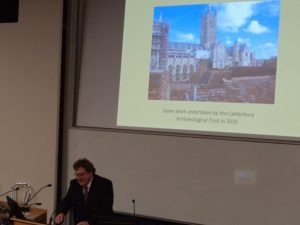
Paul Bennett begins the Frank Jenkins Lecture
Jacie decided to start with a family member whom she already knew had valuable memories of this period and topic. However, the lady she asked whether it would be ok to interview Jacie found became somewhat anxious as they started to plan where and when this would take place. This conversation took place at her home over a cup of tea, and, as Jacie reassured her it would not be difficult but more a chance for her to reminisce, she relaxed and started talking and agreed it would be fine for Jacie to just use her phone to record the conversation. In part perhaps because of the totally informal nature of the interview, Jacie found that keeping the interview on track was extremely difficult. This meant she was learning as she went along, including not to force the conversation back to the matter of food in war time, but to find ways of steering it that direction gently, without the use of leading questions, while at the same time being aware of not knowing what gems might come from an apparently non-related digression. We all do it, but repetition was also in the mix and the way ‘facts’ can change in the retelling in some ways is problematic, yet equally provides ideas about memory and how we construct a narrative from our memories to fit the remembered events, occasions, places and people.
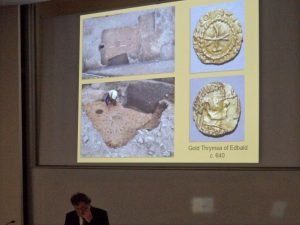
Slatters – a fantastic site and a fantastic find: gold Thrymsa of Edbald c.640
Nevertheless, for a first interview, Jacie thinks it was successful, and because her family member found it a good experience too, Jacie is intending to do a follow-up interview but next time using the proper equipment. Jacie will similarly have her questions ready, while at the same time being aware that she mustn’t use leading questions but let her interviewee make the necessary judgements. So how to guide the conversation is a key skill, as is the ability to listen more carefully, to observe the person’s demeanour and to pay particular attention to what may be missing, as well as what is there. Moreover, speaking clearly is important, as is putting the person at ease. Finally, Jacie discussed the issues surrounded transcribing, and, apart from allowing more time, she has decided that it is vital to record everything, including pauses etc because they offer ideas about emotions. Thus, taking all this together Jacie sees this as a successful pilot and great practice for the future.
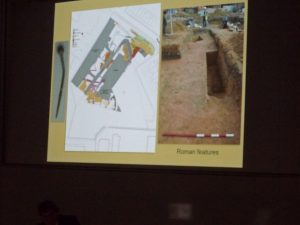
CAT’s excavations at the CCCU Canterbury Prison site
Having focused on the ideas of process – how to do …, because at this stage it would be wrong to publicise Jacie’s findings, I’m going to turn to the second presentation by Peter Joyce who is looking at the life and times of the Reverend Caleb Parfect (1685–1770). Peter is extremely interested in looking at communities through the eyes of those who served them, for as he said the parish priest was probably the man who had the greatest access to people’s lives – from cradle to the grave. Furthermore, Rev Parfect is in some ways an extraordinary individual who, as well as serving his various parishes and being a minor canon at Rochester Cathedral, lived a full family life and published 7 books. He was also heavily involved in the early life of the SPCK, and, as Peter said, his involvement in Gravesend is probably no accident in that Gravesend controlled the pilots for ships passing to and from London, the town being the place where ships berthed overnight before heading out to sea. During Parfect’s period there, among the ships were those charted to carry SPCK materials, either to the colonies or to other parts more locally, for this was a time when certain sections of the clergy were especially keen to provide moral education for the masses. The SPCK was also heavily involved in the new workhouses, a subject Parfect similarly advocated and one of his books is on this topic.
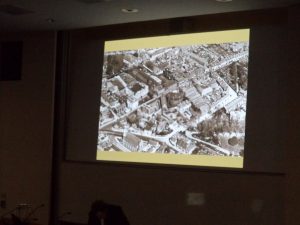
Canterbury – note Canterbury Castle as a coke store!
Whether his concern was due to his ‘humble’ beginnings, he was the son of a weaver, is not clear, and he seems to have been very industrious, raising his social status through education. He received his degree from Balliol College Oxford before immediately seeking ordination and then in 1719 he arrived in Kent where he remained for the rest of his life. He married advantageously twice and had several children, his marriages and his education providing a springboard into the counsels of leading members of Rochester society, and even to a degree those in London. So, for example, he was involved in the 1723 Workhouse Test Act and the second new workhouse in Kent, the Knatchbull workhouse at Strood.
As you might expect, such an energetic man of letters was a prodigious writer and, as well as his books, he has left a considerable legacy of letters, notes and annotations in various registers and terriers. Yet even with such an extensive archive, Peter is finding that there is little about him in the secondary literature, which has led him to consider how best to deploy his own findings, both in terms of Parfect, but also within the social, religious and political context of late Stuart and early Georgian society.
Both presentations brought a host of questions from the audience, who, as medievalists, sought clarification on certain points as well as seeing interesting crossovers thematically. Consequently, this was another great session and we are now planning the one for March.
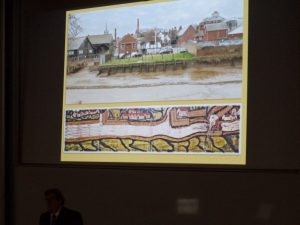
Paul discusses TS Hazard, Faversham
Finally, and extremely briefly, I want to mention two further events last week. Firstly, last night it was the Frank Jenkins Memorial Lecture where Professor Paul Bennett gave his annual round-up of the activities of Canterbury Archaeological Trust. Consequently, we went from the fossilised bones of hippopotamus major (500,000 years old) found in the excavations on Herne Bay golf course, the archaeologists found evidence of Iron Age and Middle Anglo-Saxon settlements there too, to 19th-century shield bosses (Admiral Lord Nelson) in the nave roof of Canterbury Cathedral. There were also highlights such as the excavations at Slatters Hotel; the 17th– and 18th-century hydraulics system covering a series of lakes, moat and mill pond at Ightham Mote; T.S. Hazard at Faversham, and more Neanderthals at the Shanidar Cave, as well, from Christ Church’s viewpoint, work on the prison site that has revealed traces of Roman features, medieval ditches, and a few fines such as an Anglo-Saxon pin. As always this was a tour de force, and it was great to see that CAT is still doing such excellent work during these extremely challenging times, the packed lecture theatre responding enthusiastically to Paul’s delivery.
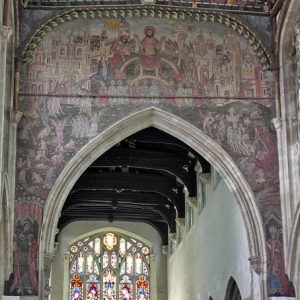
Doom or Last Judgment painting in St Thomas’ church, Salisbury [photo Imogen Corrigan]
Speaking of such times, my final event took place on Wednesday when the University of Kent’s ‘Cultures of Performance’ group (Drs Sarah Dustagheer, Rory Loughnane and Clare Wright) organised the staging of exerts from John Bale’s play King John at St Stephen’s church, Hackington. Bale was not a man to hold back and this biting satire against the abuses he saw in the Roman Catholic Church in the late 1530s presumably made at least some of its original audience angry, or at the very least decidedly uncomfortable, while having a major appeal to reformers, including Bale’s patron, Thomas Cromwell. Obviously, it wasn’t performed in the parish church in Henry VIII’s reign but in the neighbouring archdeacon’s residence, but some of its first audience would, indeed, have worshiped at St Stephen’s. Thus, for this performance to a packed church of staff, students and the public it made total sense (also the archdeacon’s house was demolished long ago!). Moreover, the occasion was made more poignant by the projection (organised by Drs Howard Griffin, Rafaella Siagkri and Emily Guerry) of late medieval Last Judgment paintings onto the chancel arch, including adaptations of the 15th-century paintings at Salisbury and Coventry (well worth seeing in those cities if you have the chance). Having taught this play, as well as performing in it at York several years ago, it was an interesting experience, and the audience was enthusiastic in its applause. However, I think for me the best part was seeing the Last Judgement painting where it would have been in 1538, an extremely appropriate use of such technology that greatly enhanced the setting of what is a fascinating church.
 Centre for Kent History and Heritage
Centre for Kent History and Heritage Sheila Sweetinburgh
Sheila Sweetinburgh 1382
1382